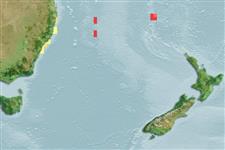Classificação / Names
Nomes comuns | Sinónimos | Catalog of Fishes(Género, Espécies) | ITIS | CoL | WoRMS | Cloffa
>
Gobiiformes (Gobies) >
Gobiidae (Gobies) > Gobiinae
Etymology: Hetereleotris: Greek, heteros = other + The name of a Nile fish, eleotris (Ref. 45335); readerae: Named for Sally Reader, who helped collect the type series.
Eponymy: Sally E Reader is an ichthyologist at the Australian Museum Research Institute. [...] (Ref. 128868), visit book page.
More on authors: Hoese & Larson.
Environment: milieu / climate zone / intervalo de profundidade / distribution range
Ecologia
marinhas demersal; intervalo de profundidade 6 - 11 m (Ref. 57078). Tropical
Southwest Pacific: eastern Australia.
Tamanho / Peso / Idade
Maturidade: Lm ? range ? - ? cm
Max length : 2.4 cm SL macho/indeterminado; (Ref. 57078); 2.1 cm SL (female)
Descrição breve
Chaves de identificação | Morfologia | Morfometria
Espinhos dorsais (total) : 7; Raios dorsais moles (total) : 8; Espinhos anais: 1; Raios anais moles: 8. Diagnosis: Pelvic fins widely separated at base, rays I,5, fifth ray unbranched, distance between bases of inner rays of two fins about equal to base of either fin. Head pore 1 by each posterior nostril, a single anterior interorbital pore, a single posterior interorbital pore, a supraorbital pore behind eye, an infraorbital pore below supraorbital pore behind eye, a lateral canal pore behind infraorbital pore, a terminal lateral-canal pore over preopercular margin, and two preopercular pores. The first gill-arch is connected by membrane to inside of gill cover. The gill opening restricted to depth of pectoral base. Anterior nostril tubular; posterior nostril a simple pore or with slightly elevated anterior rim. In males, the first two dorsal spines prolonged or not. First dorsal fin without prominent black spots or dark lines, often with small brown irregular marks near the base of the fin. A black spot subequal to pupil diameter is found behind the eye. Second dorsal-fin rays I,8 (Ref. 57078).
Body shape (shape guide): fusiform / normal.
Collected in rocky areas with some coral (Ref. 57078).
Life cycle and mating behavior
Maturidade | Reprodução | Desova | Ovos | Fecundidade | Larvas
Hoese, D.F. and H.K. Larson, 2005. Description of two new species of Hetereleotris (Gobiidae) from the south Pacific, with a revised key to species and synonymization of the genus Pascua with Hetereleotris. Zootaxa 1096:1-16. (Ref. 57078)
Categoria na Lista Vermelha da IUCN (Ref. 130435: Version 2025-1)
Ameaça para o homem
Harmless
Utilização humana
Ferramentas
Relatórios especiais
Descarregue XML
Fontes da internet
Estimates based on models
Preferred temperature (Ref.
123201): 20.9 - 22.3, mean 21.6 °C (based on 22 cells).
Phylogenetic diversity index (Ref.
82804): PD
50 = 0.5000 [Uniqueness, from 0.5 = low to 2.0 = high].
Bayesian length-weight: a=0.01023 (0.00477 - 0.02194), b=3.01 (2.83 - 3.19), in cm total length, based on LWR estimates for this (Sub)family-body shape (Ref.
93245).
Nível Trófico (Ref.
69278): 3.1 ±0.3 se; based on size and trophs of closest relatives
Resiliência (Ref.
120179): Elevada, tempo mínimo de duplicação da população menor que 15 meses (Preliminary K or Fecundity.).
Fishing Vulnerability (Ref.
59153): Low vulnerability (10 of 100).
🛈
